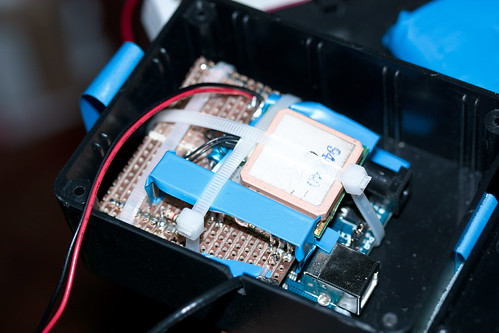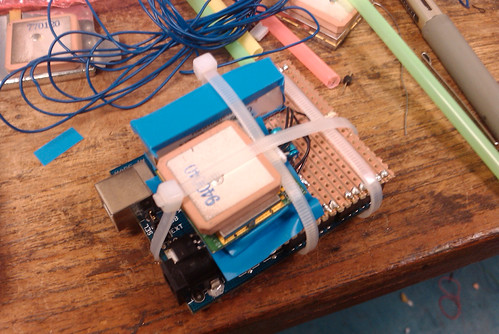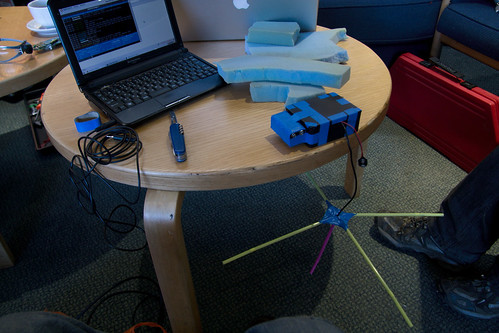I'm part of CU Spaceflight, and since we have clearance to launch high altitude balloons from a few nearby locations we often do launches for other people. A lot of the time these launches have a radio transmitter on board, so that people around the country can pick up its GPS position and help keep track of the balloon's location. We were helping with a launch a few weeks back which didn't have a radio transmitter, but instead planned to rely on a GSM based system to text the GPS coordinates back. Jon Sowman and I decided to whip up a small radio tracker based on some work that had previously been done by Iain Waugh at CUSF. Six hours later, we'd completed Ferret 1!
It consists of an Arduino with some stripboard stuck on top. The strips on the stripboard were cut down the middle with a dremel, then we soldered some pin headers on to mate with the power and lower digital pins on the arduino. We didn't need any of the higher digital pins, so the alignment issue wasn't a problem. We then stuck an EM-406a GPS unit and a Radiometrix NTX2 on top along with a few required resistors and capacitors. The radio requires an antenna, which we constructed out of some mini coax soldered to the stripboard, a small square of copper clad board with a hole drilled through and five 17cm long bits of single core wire. Four of the wires were soldered onto the corners of the copper clad board sticking outwards, while the fifth was soldered to the centre conductor of the coax. This results in a quarter-wave antenna with a ground plane, which is great because almost all the radiation goes downwards in a fairly nice pattern.
Antenna done, we hacked up Iain's code and flashed that onto the arduino and gave the whole system a quick test with a radio lying around the lab:
This was successful, so we put the whole thing in a box, taped it down and were ready to go!
We duct taped it to the main payload and launched it the next morning.
UKHAS Church Hill Site Project Orion
Uploaded by kannasnakka. - More video blogs and vloggers.
The first launch attempt didn't go so well, with too little helium resulting in us almost taking out some football players. Luckily we were able to grab the balloon and refill, getting a successful second launch. The video above is from Scott James, whose flight we were piggybacking on. He had an actual video and still camera onboard.
Sadly, shortly after crossing the meridian the GPS lost lock and for a while we didn't get any new data. Eventually, the data picked up again -- but with a suddenly discovered bug in the code! We were transmitting the decimal part of the degrees as as unsigned integer when in reality they were signed, leading to some pretty significantly incorrect results. Luckily we were able to figure out how to determine the actual position from the data it was transmitting (thanks, SpeedEvil on #highaltitude on irc.freenode.net!) and the balloon was successfully recovered.
Ferret is on its way back to us in the post now and hopefully will live to fly another day!
P.S. we got hackaday'd too!


